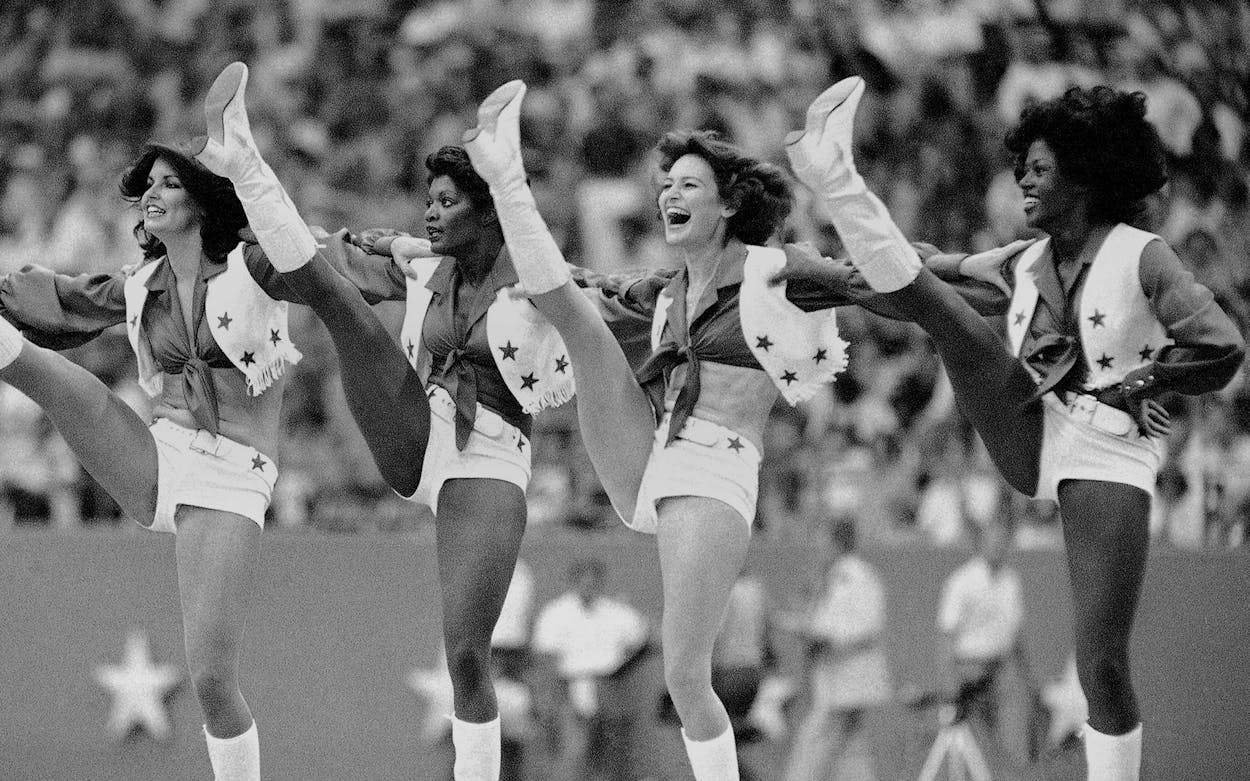Subscribe
I grew up watching women’s bodies. I think it started on movie screens, but it moved to television and locker rooms and swimming pools. There was this poster I was obsessed with at the age of five. I stared at that image on bedroom walls and 7-Elevens—all these women in blue and white uniforms. There was this one redhead with the mane of a lioness, a look of fire—and I saw in her something like the woman I wanted to be.
This was 1979 in Dallas, a year after an NFL highlight reel dubbed the Cowboys America’s Team. In other towns, at other times, I might have grown up staring at royalty or beauty-pageant queens. But in the blackland prairie of North Texas, in the late seventies, I grew up watching the Dallas Cowboys Cheerleaders.
I spent much of my early adulthood living outside Dallas. But about ten years ago, I moved back, and things I’d never noticed before began to fluoresce. I was standing in a parking lot off the roaring highway when I looked up and saw her on a billboard: that same blue and white uniform, hair like Venus on the half shell, one arm casually draped atop her head.
Thirty years had passed since I had first fallen in love with the cheerleaders. Empires had crumbled; industries had dissolved. A bustling online feminism had brought conversations about sexuality and fair pay into my everyday conversation. How was it possible so much had changed—and the Dallas Cowboys Cheerleaders were still here?
What struck me in that moment was that I knew next to nothing about the Dallas Cowboys Cheerleaders. How they started. Who those women were, what their names or inner dramas might be. I’d grown up worshipping their images, but I had no clue what their stories or their experiences in those early days had been.
That was the beginning of the project we’re releasing here next week: an eight-part podcast series all about the Cowboys cheerleaders. Because what I discovered over the next years was that the story of the cheerleaders is one of the best tales to come out of Dallas—an experiment that began at Texas Stadium in 1972 and not only survived, but extended its reach, with a reality TV show whose fans might never even watch a football game. The show illustrates the cheerleaders’ uncanny ability to ride the latest wave of pop culture, even as they cement their place as an American institution. (Their uniform is even in the Smithsonian.)
This was a journey that would take me across the past fifty years of history—across changes in women’s lives, in media, in the city of Dallas and the country itself. It would take me to the rubble of Texas Stadium and the consumer coliseum of AT&T Stadium, a.k.a. Jerry World, where the American flag is displayed above the logos for Pepsi and Miller Lite.
The journey would take me into cheerleaders’ homes, where memorabilia often fanned across a dining-room table like a grand buffet. It would take me through lore about strippers and scandals and personal sacrifice. It would take me into YouTube rabbit holes and the deep oceans of eBay, from which my purchases include: a 1981 deck of playing cards, a 1982 vinyl album of workout routines, a 2005 swimsuit-calendar making-of DVD, and a 1978 Playboy.
Over the past year, I’ve spoken to about thirty cheerleaders from the past half century. About a dozen of them appear in the podcast, alongside historians and cultural critics, but the cheerleaders carry this story. They talk about things many of us face—a search to discover their own talent and feel special, a struggle with their bodies, a hope that they could balance the inevitable frustrations and criticisms of an experience with the enormous gains they got, a frustration when their contributions were not valued (sometimes monetarily, sometimes in the public perception), a craving for the spotlight and the challenge of that scrutiny, and a desire to be sexy but not just sexy.
There was often this moment at the start of an interview with a former cheerleader.
“So is this a video?” they’d ask, watching me assemble my metal cranes of sound equipment.
“No, this is audio only.”
“Oh good.” I could feel them relax, and they’d sit however they wanted in the chair, and not worry about whether they were wearing lipstick or their hair was a little messy.
“This,” I’d say, taking a seat across from them, “is about your voice.”
You can hear their voices on Tuesday, December 7, when we release the first two episodes. Look for America’s Girls on Apple Podcasts or wherever you listen. And throughout the series, dive deeper into the stories we tell through our Pocket collection at getpocket.com/texas.
- More About:
- Sports
- Dallas Cowboys Cheerleaders
- Dallas






